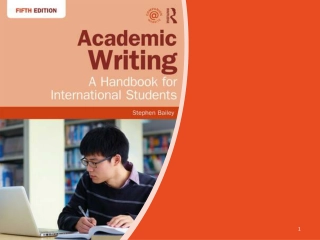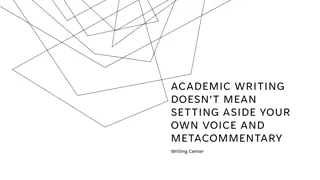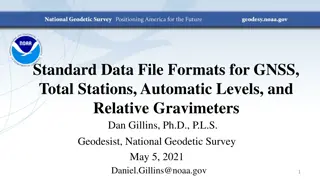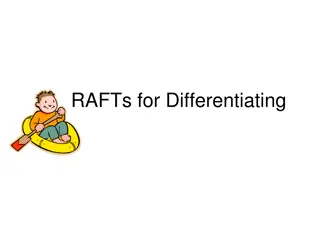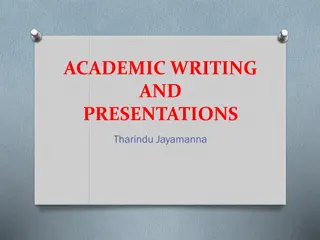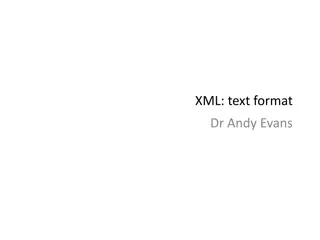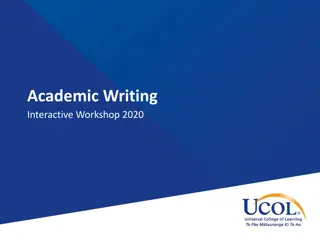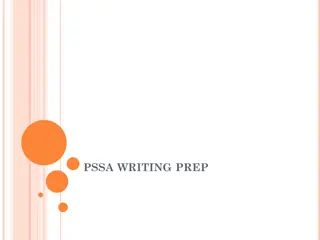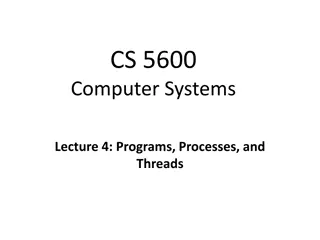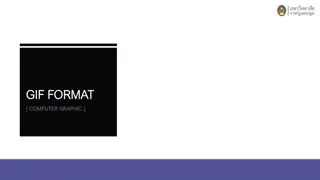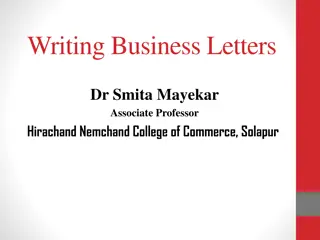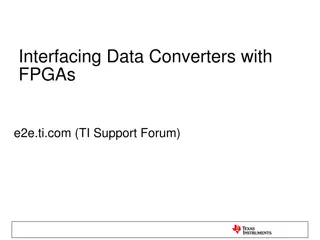Academic Writing Essentials: Background, Types, and Formats
Explore the essential aspects of academic writing in this comprehensive guide. Learn about the purpose of academic writing, common types such as projects and essays, and the formats for short and long writing tasks. Discover the features of academic writing like accuracy, objectivity, and formal style to enhance your writing skills.
Download Presentation

Please find below an Image/Link to download the presentation.
The content on the website is provided AS IS for your information and personal use only. It may not be sold, licensed, or shared on other websites without obtaining consent from the author. Download presentation by click this link. If you encounter any issues during the download, it is possible that the publisher has removed the file from their server.
E N D
Presentation Transcript
IE178 TECHNICAL AND PROFESSIONAL COMPOSITION 2nd Presentation 1. The writing process 2. Elements of writing 3. Accuracy in writing 4. Writing models : Background to writing : Argument and discussion : Abbreviations : Formal letters and emails Dr. Abdulcabbar Yavuz
Part 1. The writing process Chapter 1.1. Background to writing
Chapter 1.1. Background to writing In this section: The names of different writing tasks The format of long and short writing tasks The use of sentence and paragraphs
Chapter 1.1. Background to writing 1. The purpose of academic writing Writers should be clear why they are writing. The most common reasons for writing include: to report on a piece of research the writer has conducted to answer a question the writer has been given or chosen to discuss a subject of common interest and give the writer s view to synthesise research done by others on a topic Can you suggest any other reasons? to present a hypothesis for consideration by others to make notes on something read or heard
Chapter 1.1. Background to writing 1. The purpose of academic writing Academic writing attempts to be accurate and objective. What is other features? Impersonal style Formal vocabulary, lack of idioms Use of citation/references Use of both passive and active Cautious
Chapter 1.1. Background to writing 1. Common types of academic writing Project Dissertation / thesis Notes Paper Report Essay
Chapter 1.1. Background to writing 3. The format of long and short writing tasks Short essays (including exam answers) generally have this pattern: Introduction Main body Conclusion Longer essays may include: Introduction Main body Literature review Case study Discussion Conclusion References Appendices
Chapter 1.1. Background to writing 3. The format of long and short writing tasks Dissertations and journal articles may have: Abstract List of contents List of tables Introduction Main body Literature review Case study Findings Discussion Conclusion Acknowledgements References Appendices
Abstract References Appendix Acknowledgements Literature review Case Study
Chapter 1.1. Background to writing 4. The features of academic writing There is considerable variation in the format of academic writing required by different schools and departments. Your teachers may give you guidelines, or you should ask them what they want. But some general features apply to most formats.
a) Title b) Subtitle c) Heading d) Sentence e) Phrase f) Paragraph
Chapter 1.1. Background to writing 5. Some other common text features Reference to sources using citation: According to Tamura et al. (2009) The use of abbreviations to save space: docosahexaenoic acid (DHA) Italics: used to show words from other languages: Tamura et al. (= and others) Brackets: used to give subsidiary information or to clarify a point: . . . but others (short-chain fatty acids) come from cheaper sources such as soya.
Chapter 1.1. Background to writing 6. Simple and complex sentences Study the table below. Annual vehicle production 2005 9 All sentences contain verbs: In 2005 the company produced over 135,000 vehicles. Between 2005 and 2006 vehicle production increased by 20 per cent. In 2005 the company produced over 135,000 vehicles but between 2005 and 2006 production increased by 20 per cent. Over 164,000 vehicles were produced in 2007; by 2009 this had fallen to 123,000.
Chapter 1.1. Background to writing 6. Simple and complex sentences Annual vehicle production 2005 9 Write two simple and two complex sentences using data from the table above. In 2007 the company produced nearly 165,000 vehicles. Vehicle production fell in 2008. In 2009 fewer vehicles were made than in the four previous years. Between 2005 and 2009 vehicle production peaked in 2007, when the number reached 164,000.
Part 2. Elements of writing Chapter 2.1. Argument and Discussion
Chapter 2.1. Argument and discussion 1. Discussion vocabulary Essay titles commonly ask students to discuss a topic: Children will learn a foreign language more easily if it is integrated with another subject Discuss. + - benefit advantage a positive aspect pro (informal) plus (informal) one major advantage is . . . drawback disadvantage a negative feature con (informal) minus (informal) a serious drawback is . . .
benefits / advantages drawback/ disadvantages negative benefits / advantages drawback/ disadvantages benefit / advantage
Chapter 2.1. Argument and discussion 2. Organisation The discussion section can be organised in two ways; by grouping the benefits in one paragraph and the disadvantages in another (vertical), by examining the subject from different viewpoints (horizontal). For example, the following essay title can be discussed in the two ways as shown: Prisons do little to reform criminals and their use should be limited Discuss.
Vertical Horizontal
Chapter 2.1. Argument and discussion 2. Organisation What are the advantages of each format (i.e. vertical and horizontal)? Vertical: a simpler pattern suitable for short essays Horizontal: this allows a more complex approach in longer essays
Chapter 2.1. Argument and discussion 3. Practice A Discuss whether some employees should be permitted to work from home. Brainstorm the positive and negative aspects, and then write an outline using one of the structures (vertical or horizontal). + - Employees may feel isolated May not suit all employees Home may contain distractions Requires different management style No time spent commuting to work Gives employees more flexibility Saves expensive office space
Chapter 2.1. Argument and discussion 3. Practice A Discuss whether some employees should be permitted to work from home. (a) Introduction: reasons for growth of home-working: development in communication technology, demand for more flexible work patterns. (b) Drawbacks: Employees may feel isolated, be distracted by activities at home. May not suit all employees, some prefer more direct management. (c) Benefits: Companies need to provide less office space, less time spent on commuting = more work time, employees have more flexibility. (d) Discussion: Of benefit to certain employees in some roles, but necessary to have regular contact with colleagues and managers.
Chapter 2.1. Argument and discussion 4. The language of discussion Use impersonal phrases instead such as: It is generally accepted that It is widely agreed that Most people appear It is probable that The evidence suggests that These phrases suggest a minority viewpoint: It can be argued that One view is that When you are supporting your opinions with sources use phrases such as: According to Emerson (2003) Poledna (2007) claims that
Chapter 2.1. Argument and discussion 5. Counter-arguments Counter-arguments are ideas that are opposite to your ideas. In an academic discussion you must show that you are familiar with both sides of the argument, and provide reasons to support your position. It is usual to deal with the counter-arguments first, before giving your view.
Chapter 2.1. Argument and discussion 5. Counter-arguments What is the writer s position in the following example, on the topic of prisons (2 above)? It is claimed that prisons are needed to isolate dangerous criminals from society, but while this may be true in some cases, more commonly prisons act as universities of crime , which reinforce criminal behaviour. The writer s position is essentially critical of the way prisons work
Chapter 2.1. Argument and discussion 5. Counter-arguments write two more sentences using ideas from title in 3 which is some employees should be permitted to work from home. Counter-argument Your position Some people believe that homeworkers become isolated, but this can be avoided by holding weekly meetings for all departmental staff. but in practice there seems little evidence for this. It has been claimed that employees may waste time at home, Although home-working may save companies money by reducing the need for office space, employees need to have a well- equipped workspace in their home.
Chapter 2.1. Argument and discussion 6. Providing evidence Normally your conclusions on a topic follow an assessment of the evidence. You must show that you have studied the relevant sources since only then can you give a balanced judgement. Read the text in your handbook page 106 and answer the question on page 107. 1 Claims for `digital natives 2. Arguments against 3. Writer s viewpoint
Chapter 2.1. Argument and discussion 7. Practice B Write two paragraphs on the topic: Is the exploration of space worthwhile? Use the ideas below and make your stance clear.
Chapter 2.1. Argument and discussion 7. Practice B (example answer) There has been considerable debate about the value of space exploration, in view of the high costs involved. Supporters such as Donnet- Kammel (2005) claim that this is a vital method of collecting data about the structure of the universe, and additionally point out that there have been many practical benefits arising from the space programme, such as satellite communication. The example of the space station is also given as an instance of the value of the research programme in encouraging international co-operation. In contrast, critics (e.g. Soroka, 2000) point to the huge costs involved in launching space probes, claiming that these resources would be better devoted to solving the serious earthly problems of hunger and disease. Furthermore, they argue that much of the space programme is effectively a testing ground for new weapons, such as missiles, and brings little benefit to ordinary people. In the context of the current economic crisis, a more critical approach is clearly needed in deciding which of those projects have real value.
Part 3. Accuracy in writing Chapter 3.1. Abbreviations
Chapter 3.1. Abbreviations 1. Types of abbreviations Abbreviations are an important and expanding feature of contemporary English, widely used for convenience and space- saving. Students need to be familiar with general and academic abbreviations. Types of abbreviations (a) Shortened words: without the writer being aware of the original form Bus comes from omnibus . Refrigerator is still better in written English than the informal fridge . Public house is now very formal ( pub is acceptable), but television or TV should be used instead of the idiomatic telly . (b) Acronyms: initial letters of a name or phrase (e.g. AIDS = Acquired Immune Deficiency Syndrome). They are pronounced as words. (c) Other abbreviations :names of countries, organisations and companies (USA/ BBC/ IBM), and also abbreviations that are only found in written English (e.g. PTO).
Chapter 3.1. Abbreviations 2. Some common abbreviations BSc CV DIY EU GM HRM human resource management ICT information and communications technology IMF International Monetary Fund MA Master of Arts PG Postgraduate PhD Doctor of Philosophy PLC public limited company PR public relations UG undergraduate UN United Nations VC Vice-Chancellor WTO World Trade Organisation Bachelor of Sciences curriculum vitae do-it-yourself European Union genetically modified
Chapter 3.1. Abbreviations 3. Punctuation many standard abbreviations have a full stop after them to show that it is a shortened form lt. = litre govt. (government) co. (company) Oct. (October). no standard pattern for using full stops, so both BBC and B.B.C. are used. a tendency to use full stops less. The important thing is to employ a consistent style in your work.
Chapter 3.1. Abbreviations 4. Duplicate abbreviations Abbreviations can be confusing. PC, for example, may stand for personal computer but also politically correct or something else. It is useful to be aware of these potential confusions. A good dictionary should be used to understand more unusual abbreviations.
Chapter 3.1. Abbreviations 5. Abbreviations in writing anon. (no author) asap as soon as possible cf. compare ed. editor/ edition e.g. for example et al. (used for giving names of multiple authors) Fig. figure (for labelling charts and graphs) ibid. in the same place (to refer to source mentioned immediately before) anonymous i.e. that is thousand take careful note no date (i.e. an K NB. nd. undated source) op. cit. mentioned previously in the source and others p.a. yearly (per annum) pages postscript with reference to pp. PS re.
Chapter 3.1. Abbreviations 6. Practice (a) information and communications technology / higher education/ and others (b) genetically modified/ for example (c) that is / the World Trade Organisation (d) note/ curricula vitae/ Human Resources (e) The Organisation for Economic and Cultural Development/ The United Arab Emirates (f) The European Union/ Value Added Tax (g) Doctor of Philosophy (thesis)/ Tuberculosis/ south east (h) Figure 4/ world wide web (i) Vice-Chancellor/ Postgraduate Certificate of Education (j) Public relations/ approximately/ $75,000 (k) With reference to/ Annual General Meeting/ as soon as possible (l) Professor/ Master of Science/ Master of Arts
Part 4. Writing Models Chapter 4.1. Formal letters and emails
Chapter 4.1. Formal letters and emails 1. Letters letters are still important for formal matters, or when an email address is unknown. They are also considered to be more reliable than emails. Due to its convenience email is increasingly used for semi-formal as well as informal communication. It is widely seen as a way of having a permanent record of an arrangement or discussion.
a) address of sender b) address of recipient c) sender s reference d) date e) greeting f) Subject headline g) reason for writing h) further details i) request for response j) ending k) signature l) writer s name and job title
Chapter 4.1. Formal letters and emails 1. Letters Note the following points: (a) The example above is addressed to a known individual and the ending is Yours sincerely . However, when writing to somebody whose name you do not know, e.g. The Manager, use Dear Sir and Yours faithfully. (b) A formal letter generally uses the family name in the greeting (Dear Ms Tan). Certain organisations may, however, use a first name with a family name or even a first name alone (Dear Jane Tan, Dear Jane). (c) If the sender includes a reference it is helpful to quote it in your reply.
Chapter 4.1. Formal letters and emails 2. Practice A Write a reply to Mr Bramble making the following points: (a) You will attend the interview on the date given. (b) You would like to have the interview one hour later, due to train times.
Chapter 4.1. Formal letters and emails 3. Emails Starting If you know the recipient: Hi Sophie, Dear Sophie, Hello Sophie If you have not met the recipient it may be safer to use: Dear Sophie Gratton, Dear Ms Gratton, Dear Dr Gratton to send an email to a large group (e.g. colleagues): Hi everyone, Hello all Finishing In all cases to close the message you can use: Regards, Best wishes, Best regards You may also add a standard formula before this: Look forward to meeting next week/ Let me know if you need further information. The main text You can use common contractions (I ve, don t) and idiomatic language, but the normal rules for punctuation should be followed to avoid confusion. check for spelling and grammar problems before pressing the send key. Note that emails tend to be short, although longer documents may be added as attachments.
Chapter 4.1. Formal letters and emails 4. Practice B Read the following and decide who the sender and recipient might be. Would Rachel expect a reply? Sender = student / recipient = teacher Reply is unlikely, unless recipient needs to comment on the attached paper.
Chapter 4.1. Formal letters and emails 5. Practice C Write suitable emails for the following situations: (a) You are writing to Mark, a colleague at work, to ask him to suggest a time to meet you tomorrow Hi Mark, We need to schedule a short meeting tomorrow. What time would suit you? See you soon, Hello Tricia, I m looking for another source for this month s essay. Could you recommend something suitable? Best wishes, (b) Write to your teacher, Tricia James, to ask her to recommend another book for your current essay.
Chapter 4.1. Formal letters and emails 5. Practice C Write suitable emails for the following situations: (c) Write to a group of classmates asking them how they want to celebrate the end of the course. Hi everyone, It s only a week before the end of the course what are we going to do to celebrate? Let me have your ideas I ll pass them on and hopefully get something good fixed up for Sat 12th! Dear Tim Carey, I ve never had this book, so I can t return it. Can you check your records please? (d) Write an email in response to the one shown in page 253. You have never had that book.


